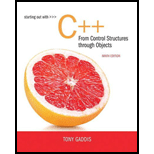
Starting Out with C++ from Control Structures to Objects (9th Edition)
9th Edition
ISBN: 9780134498379
Author: Tony Gaddis
Publisher: PEARSON
expand_more
expand_more
format_list_bulleted
Concept explainers
Expert Solution & Answer
Chapter 1.2, Problem 1.4CP
Explanation of Solution
Steps involved in the fetch/ decode/ execute cycle:
The
Fetch:
- The next instruction is fetched by the control unit from the main memory and it is stored in the instruction register.
- Finally, at the end of fetch operation, PC (Program Counter) points to the next instruction that will be read at the decode cycle.
Decode:
- The next operation in the instruction cycle is decoding operation, which is performed...
Expert Solution & Answer
Want to see the full answer?
Check out a sample textbook solution
Students have asked these similar questions
Explain the steps of the fetch–decode–execute cycle.
Describe the fetch/execute cycle
This article provides an explanation of interrupt latency and context switching time.
Chapter 1 Solutions
Starting Out with C++ from Control Structures to Objects (9th Edition)
Ch. 1.2 - Why is the computer used by so many different...Ch. 1.2 - List the five major hardware components of a...Ch. 1.2 - Internally, the CPU consists of what two units?Ch. 1.2 - Prob. 1.4CPCh. 1.2 - Prob. 1.5CPCh. 1.2 - Prob. 1.6CPCh. 1.2 - Prob. 1.7CPCh. 1.2 - Prob. 1.8CPCh. 1.2 - What do you call a program that performs a...Ch. 1.2 - Word processing programs, spreadsheet programs,...
Ch. 1.3 - What is an algorithm?Ch. 1.3 - Why were computer programming languages invented?Ch. 1.3 - Prob. 1.13CPCh. 1.3 - Prob. 1.14CPCh. 1.3 - Prob. 1.15CPCh. 1.3 - Prob. 1.16CPCh. 1.3 - Prob. 1.17CPCh. 1.5 - Prob. 1.18CPCh. 1.5 - Prob. 1.19CPCh. 1.5 - Describe the difference between a program line and...Ch. 1.5 - Prob. 1.21CPCh. 1.5 - What happens to a variables current contents when...Ch. 1.5 - What must take place in a program before a...Ch. 1.5 - Prob. 1.24CPCh. 1.7 - What four items should you identify when defining...Ch. 1.7 - Prob. 1.26CPCh. 1.7 - What is a hierarchy chart?Ch. 1.7 - Prob. 1.28CPCh. 1.7 - Describe what a compiler does with a programs...Ch. 1.7 - Prob. 1.30CPCh. 1.7 - Is a syntax error (such as misspelling a key word)...Ch. 1.7 - What is the purpose of testing a program with...Ch. 1.7 - Briefly describe the difference between procedural...Ch. 1 - Prob. 1RQECh. 1 - What is the difference between system software and...Ch. 1 - Prob. 3RQECh. 1 - Why must programs written in a high-level language...Ch. 1 - Why is it easier to write a program in a...Ch. 1 - Prob. 6RQECh. 1 - Prob. 7RQECh. 1 - Prob. 8RQECh. 1 - The job of the ________ is to fetch instructions,...Ch. 1 - Internally, the CPU consists of the _______ and...Ch. 1 - Prob. 11RQECh. 1 - The two general categories of software are...Ch. 1 - A program is a set of _______.Ch. 1 - Prob. 14RQECh. 1 - _______ is the only language computers really...Ch. 1 - __________ languages are close to the level of...Ch. 1 - ________ languages are close to the level of the...Ch. 1 - Prob. 18RQECh. 1 - Words that have special meaning in a programming...Ch. 1 - Prob. 20RQECh. 1 - Prob. 21RQECh. 1 - __________ characters or symbols mark thebeginning...Ch. 1 - Prob. 23RQECh. 1 - Prob. 24RQECh. 1 - Prob. 25RQECh. 1 - Prob. 26RQECh. 1 - __________ is information a program gathers from...Ch. 1 - __________is information a program sends to the...Ch. 1 - Prob. 29RQECh. 1 - Available Credit The following steps should be...Ch. 1 - Sales Tax Design a hierarchy chart or flowchart...Ch. 1 - Account Balance Design a hierarchy chart or...Ch. 1 - The variable x starts with the value 0. The...Ch. 1 - The variable j starts with the value 10. The...Ch. 1 - The variable a starts with the value 1. The...Ch. 1 - Find the Error 36. The following pseudocode...
Knowledge Booster
Learn more about
Need a deep-dive on the concept behind this application? Look no further. Learn more about this topic, computer-science and related others by exploring similar questions and additional content below.Similar questions
- How does interrupt latency relate to the time it takes to switch contexts?arrow_forwardEach element in the table that contains the interrupt vectors corresponds to a separate data group.arrow_forwardExplain the steps in the fetch–decode–execute cycle. Your explanation should include what is happening in the various registers.arrow_forward
- Explore the challenges and solutions related to handling exceptions and interrupts in ALU instructions.arrow_forwardExplain True/False. Statement - The data transfer between memory and I/O devices using programmed I/O is faster than interrupt driven I/O.arrow_forwardIn 8051 assembly language: If one of the elements in a list in ROM is more than 8 bits in binary as shown below list: DB 9H,12H,2021H How can I separate 2021 into 2 bytes in RAM? So that one location in RAM holds 20, and the other 21. (Values in RAM should be in BCD format)arrow_forward
arrow_back_ios
SEE MORE QUESTIONS
arrow_forward_ios
Recommended textbooks for you
 Systems ArchitectureComputer ScienceISBN:9781305080195Author:Stephen D. BurdPublisher:Cengage Learning
Systems ArchitectureComputer ScienceISBN:9781305080195Author:Stephen D. BurdPublisher:Cengage Learning

Systems Architecture
Computer Science
ISBN:9781305080195
Author:Stephen D. Burd
Publisher:Cengage Learning